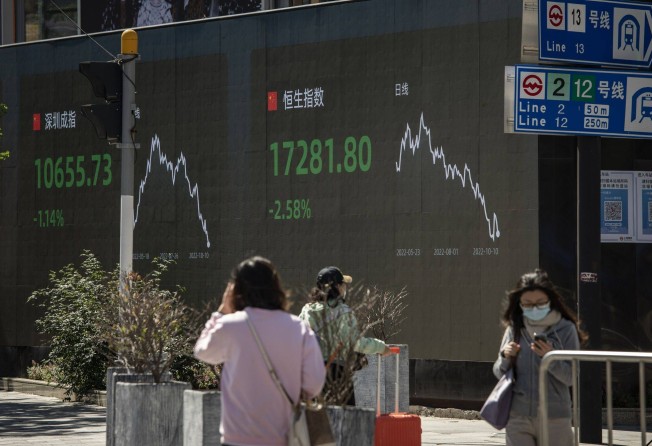
China’s US$3.5 trillion stock sell-off seen nearing end, as share buy-backs, buying by fund managers indicate recovery
- Share buy-backs by mainland-traded companies, historically an indicator of rising stock prices, are up 86 per cent this year
- This week at least 26 asset-management firms have unveiled plans to invest a combined US$249 million in their own funds

A sell-off of China stocks that has erased US$3.5 trillion of market value this year may be nearing its end, based on a number of sentiment gauges including share buy-backs, self-investment by fund managers and attractive valuations.
The average combined valuation of companies in the CSI 300 Index has cheapened to about 6 per cent below the 10-year average after the benchmark slumped to near a two-year low. A weakening offshore yuan, growing concerns about China’s economic slowdown and faster rate increases in the US all roiled markets on Thursday.
However, several signs hint the market is near its bottom.
Corporate stock repurchases in 2022 have surpassed any annual volume in local market history, according to China International Capital Corp (CICC). Meanwhile, asset managers including giants E Fund Management and Southern Asset Management have been pouring their own money into fund products. At the same time, the ratio of onshore listed companies trading at a discount to their net-asset value is close to the level during the global financial crisis in 2008.

“With the risk premium around its record high, stock valuations are very attractive generally,” said HSBC Jintrust Fund Management in a quarterly strategy report on Wednesday. “That points to a good time for allocations of [yuan-traded] A shares. The risk appetite is expected to pick up in the fourth quarter, alongside the economy and corporate earnings.”
About 1,100 mainland-listed companies have spent 158.9 billion yuan (US$22 billion) buying back their own shares so far this year, an 86 per cent increase from the same period a year ago, according to data from CICC.
Share prices historically rise by an average of 5.1 per cent in the six months after a buy-back, and 13 per cent after 12 months, according to Founder Securities.
This week, at least 26 asset-management firms have unveiled plans to invest a combined 1.8 billion yuan in their own funds, showcasing confidence in the stock market. This would swell outlays to about 7 billion yuan the value of such investments this year, according to data provider eastmoney.com.
For example, Guangzhou-based E Fund Management, which oversees 2.7 trillion yuan in assets, said it would put 150 million yuan into its stock-focused funds and Southern Asset Management said it would invest 100 million yuan in three mixed funds it manages. Both money managers said the decisions were based on long-term confidence in the capital market.
Some 403 companies traded below their book value as of Wednesday, according to Bloomberg data. That represents 8.6 per cent of the total listings on the Shanghai and Shenzhen bourses, compared with 11 per cent during the height of the global financial crisis in 2008.
On top of these measures, traders also point to a pickup in margin trading and shrinking turnover on the broader market as signals that the worst for stocks may already be over. Other indicators such as the number of stocks rising by the daily limit and the number trading above their 60-day highs have largely hit bottom and should rise going forward, which will help boost risk appetite, according to Guosheng Securities.
Still, it remains to be seen whether the long-expected rebound will materialise, as some of the factors holding back growth still linger.
Chief among these is China’s zero-Covid policy, which has been a major curb on the property and travel sectors and continues to unnerve traders as it causes lockdowns in areas hit by Covid-19 outbreaks.
In a keynote address to the opening session of Communist Party’s 20th Party Congress, President Xi Jinping signalled no change to the zero-Covid policy, and in the week before the congress, the party-owned People’s Daily published a series of articles defending the stance.
BOC International expects local stocks to build a “W-shaped” bottom before a sustained rally takes hold, as bets on some policy easing increase and the beaten-down valuations can withstand further sell-offs.
“A shares will show resilience to selling pressure because of the appealing valuations,” said Wang Jun, an analyst at the Shanghai-based brokerage. Once policy expectations are reset, it will trigger a significant jump in stock prices, he added.
